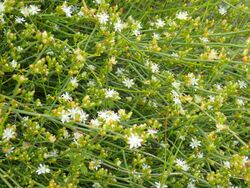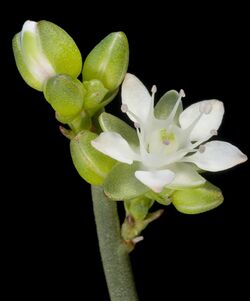Biology:Macarthuriaceae
| Macarthuriaceae | |
|---|---|

| |

| |
| Macarthuria australis Hügel ex Endl.[4] | |
| Scientific classification | |
| Kingdom: | Plantae |
| Clade: | Tracheophytes |
| Clade: | Angiosperms |
| Clade: | Eudicots |
| Order: | Caryophyllales |
| Family: | Macarthuriaceae Christenh.[1][2] |
| Type genus | |
| Macarthuria Hugel ex Endl.[3]
| |
| Genera | |
Macarthuriaceae is a family of plants in the order Caryophyllales and consists of a single genus, Macarthuria.
Description
Macarthuriaceae are rigid or wiry, rush-like herbs or subshrubs with green stems and reduced leaves.[2][5] The small flowers have five perianth members, sometimes also five "petals", and eight stamens fused at the base.[5]
Taxonomy
In 2009, Macarthuria was placed with Limeum in the Limeaceae, based on its morphology, but at that time no molecular material of Macarthuria had been examined.[6] Prior to this, Endress and Bittrich had placed it in the family Molluginaceae.[7] However, in 2011, molecular evidence was published, showing that Macarthuria is sister to all core Caryophyllales.[8][9] Thus, Macarthuria needed to be placed in a family of its own, Macarthuriaceae.[2][1]
References
- ↑ 1.0 1.1 Stevens, P. F. (July 2017). "Macarthuriaceae (Caryophyllales)". Angiosperm Phylogeny Website. http://www.mobot.org/MOBOT/research/APweb/orders/Caryophyllalesweb.htm#Macarthuriaceae.
- ↑ 2.0 2.1 2.2 Christenhusz, M.J.M.; Brockington, S.F.; Christin, P.-A.; Sage, R.F. (2014). "On the disintegration of Molluginaceae: a new genus and family (Kewa, Kewaceae) segregated from Hypertelis, and placement of Macarthuria in Macarthuriaceae". Phytotaxa 181 (4): 238. doi:10.11646/phytotaxa.181.4.4. ISSN 1179-3163.
- ↑ "Macarthuria". Australian Plant Name Index (APNI), IBIS database. Centre for Plant Biodiversity Research, Australian Government. https://biodiversity.org.au/nsl/services/rest/name/apni/57102.
- ↑ "Macarthuria australis". Australian Plant Name Index (APNI), IBIS database. Centre for Plant Biodiversity Research, Australian Government. https://biodiversity.org.au/nsl/services/rest/name/apni/57140.
- ↑ 5.0 5.1 Lepschi, B.J. (1996) A taxonomic revision of Macarthuria (Molluginaceae) in Western Australia. Nuytsia 11: 37-54. Retrieved 9 December 2018.
- ↑ "An update of the Angiosperm Phylogeny Group classification for the orders and families of flowering plants: APG III". Botanical Journal of the Linnean Society 161 (2): 105–121. 2009. doi:10.1111/j.1095-8339.2009.00996.x. ISSN 0024-4074.
- ↑ Endress, M.E., & Bittrich, V. (1993) Molluginaceae. Pp. 419-425, in Kubitzki, K., Rohwer, J.G., & Bittrich, V. (eds), The Families and Genera of Vascular Plants. II. Flowering Plants: Dicotyledons, Magnoliid, Hamamelid and Caryophyllid Families.Springer, Berlin.
- ↑ Brockington, S.F.; Walker, R.H.; Glover, B.J.; Soltis, P.S.; Soltis, D.E. (2011). "Complex pigment evolution in the Caryophyllales". New Phytologist 190 (4): 854–864. doi:10.1111/j.1469-8137.2011.03687.x. ISSN 0028-646X.
- ↑ Christin, P.-A.; Sage, T.L.; Edwards, E.J.; Ogburn, R.M.; Khoshravesh, R.; Sage, R.F. (2011). "COMPLEX EVOLUTIONARY TRANSITIONS AND THE SIGNIFICANCE OF C3-C4 INTERMEDIATE FORMS OF PHOTOSYNTHESIS IN MOLLUGINACEAE". Evolution 65 (3): 643–660. doi:10.1111/j.1558-5646.2010.01168.x. ISSN 0014-3820.
Wikidata ☰ Q21223518 entry
 |

